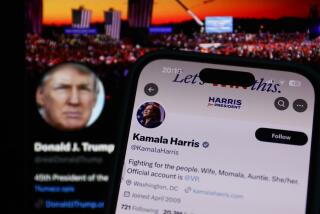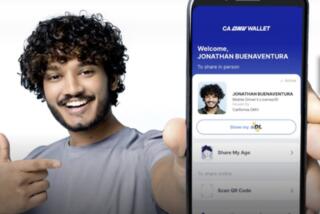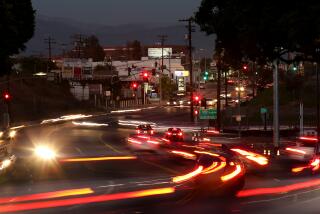Fighting the Fakes
The purchase of fake IDs, long a problem on the streets, has invaded cyberspace to become the latest headache for state and federal authorities.
Now accessible through the click of a mouse, a number of Web sites offer replicas of some of the most coveted and sensitive personal documents: state identification cards, driverâs licenses, birth certificates and Social Security cards, all guaranteed to look like their legitimate counterparts.
And boy, do they look good.
âThe ones weâve seen are better than whatâs [sold] on the street,â said Marissa Hernandez, a section chief in Los Angeles for the Immigration and Naturalization Service.
The trend has put new enforcement strains on agencies such as the INS and the state Department of Motor Vehicles, already overwhelmed with the scope of more traditional counterfeiting operations.
Street sales of forged documents have reached ominous proportions in the Los Angeles area, authorities say. In the last two years alone, INS agents have seized close to 3 million counterfeit documents from just one organized crime ring. The confiscated material, which included green cards, Social Security cards, driverâs licenses and proof-of-insurance certificates, had a street value of more than $140 million.
The extent of Web-based sales is unknown, but authorities are well aware of the budding industryâs potential.
âItâs a big moneymaker,â one DMV official said.
And, as is clear from their Web sites, various operations are not shy about flaunting their skills as counterfeiters.
Boasts one on the Web: âWe continue to be a major headache to several DMV and law enforcement agencies around the world. We can provide you with all the illegal and fake photo IDs that you are not by U.S. law [allowed] to have.â
Another Web site advertises: âWe will provide you with . . . exact novelty replicas in every detail of the current [state] IDs. . . . We do whatever security measure that state has (i.e. UV, watermark, hologram, seal, reflective laminate coating).â
A scroll down the page reveals samples of very realistic driverâs licenses, Social Security cards and birth certificates, at $40 (for the Social Security card) to about $85 (for licenses and birth certificates).
The site says it sells the documents with a tiny sticker that labels them as ânoveltyâ identification. But after that disclaimer, the user is told that âif you choose to peel it off . . . that is entirely up to you and you assume all responsibility/liability after that point.â
Compounding the enforcement problem, most of these operations are based outside the U.S., Hernandez said. Several being investigated by the agency are in Canada.
âWeâre looking at [Web-based operations] more and more, working with the FBI . . . and weâre working a lot with the Royal Canadian Mounted Police,â she said.
The DMV is equally aware of the trend, said Vito Scattaglia, commander of the agencyâs division of investigations.
âItâs a big problem. We have a team of investigators, all they do is computer-type [analyses],â he said.
Los Angeles Is the Hub of Counterfeiters
Yet in the cat-and-mouse game against counterfeiters, documents sold over the Internet still represent a relatively minor element, said Hernandez. In a way, the fake IDsâ sophisticated nature turns into a shortcoming, since they are harder to produce in large numbers and must be sold at higher prices to offset production costs.
And at least for now, access to them is somewhat limited.
âPeople have to have a computer, they have to know their way around the Internetâ to purchase the documents online, Hernandez said.
Although the future might produce a change, Web-advertised documents for now lag behind the broader threat of mass-produced documents sold on the streets. Most agencies are therefore directing the bulk of their resources to halting the production of less elaborate forged documents, whose sales across the country constitute the lifeblood of a multimillion-dollar underground industry.
The hub of counterfeit operations is in Los Angeles, most likely because 52% of the nationâs 5.8 million illegal immigrants live in the area, INS officials said. According to INS Special Agent Louis Rodi, local counterfeiting rings produce enough documents to âprovide one to just about every illegal immigrant in Los Angeles.â
These groups sell their wares mainly through street vendors, who stand inconspicuously on busy sidewalks looking for the next costumer--an illegal immigrant desperate for a job, a seeker of a false identity, an underage youngster hoping to get into a bar.
The street vendor is but the tip of the counterfeiting iceberg. He takes orders from buyers, asks for their biographical information and a photo, and negotiates the price of the document. Forty dollars will buy a forged driverâs license in Los Angeles, for example. And often the documents are sold in sets, so a kit with a fake green card, Social Security card and driverâs license can cost $70 to $100, INS agents said.
Once an order is taken, the vendor passes it down to a ârunner,â who is in charge of going to the âmill,â an apartment or trailer with laminating machines, typewriters and computer equipment. At the mill, biographical information is filled into documents, photos are pasted and cards are laminated.
Major forgery rings usually own several mills, each in charge of producing a few hundred documents. Mills get their stock from a warehouse, basement or storage facility, where printing presses and industrial equipment allow for the mass production of hundreds of thousands of documents.
The impact of counterfeiting rings, as the INS and federal prosecutors have discovered, does not remain local. Documents produced by the biggest organization in Los Angeles--the San German/Castorena ring--have turned up in 55 cities and 32 states, according to Los Angeles INS district director Tom Schiltgen.
Whether they are bought on the street or the Web, the use of these bogus items has major repercussions.
âIt hurts our economy, because people with forged documents are taking jobs away from people who really have legal documents,â said INS special agent Richard Jackson.
One of the most common uses of such fakes involves illegal immigrants who show a counterfeit green card as proof of immigration status to a potential employer, INS officials said.
Scattaglia said a more serious situation is created when people use a counterfeit item, such as a birth certificate or Social Security card, to obtain a legitimate document, such as a driverâs license.
In such a case, the DMV âactually issues a legitimate document,â but it is fraudulent because it might be based on a false birth certificate, he said. This complicates matters for authorities, because the person with the fraudulent license will be part of the DMV system.
âIt snowballs from there,â he said, because people can then use the card to obtain many things. âItâs a big problem because [a license] is required with everything you do in daily life, so itâs a highly sought-after document.â
âDo You Have a Valid ID?â
In banks, stores and all kinds of situations, âthe first thing asked is: Do you have a valid ID? So the demand is to obtain it at whatever cost,â he said.
In efforts to stop fraud, the DMV does random inspections of documents brought in by applicants. On a typical day at one of the agencyâs busiest offices, itâs common to have 20 or more arrests of people trying to get a license with forged documents, Scattaglia said.
An even more dangerous trend fueled by the use of forged IDs has been the highly profitable, increasingly common practice of identity theft, officials agree.
While investigating a counterfeiting ring in Los Angeles, Robert Dugdale, an assistant U.S. attorney, interviewed individuals who had stolen hundreds of credit cards from peopleâs mail and then bought fake driverâs licenses with those names from street vendors. At least one major credit card company suffered multimillion-dollar losses as a result, Dugdale said.
Given the far-reaching repercussions of the use of forged documents, it comes as no surprise that agencies constantly follow counterfeitersâ tracks, aiming to learn what the latest versions of forged documents look like, and trying to come up with harder-to-imitate security features.
Jim Hesse, chief intelligence officer at the INS forensics document laboratory in Washington, says his unit analyzes forged documents from all over the country. The quality of the items varies widely, he said, âfrom really poor to very good.â
But relatively inexpensive color printers, scanners and new software now available on the market are making the job harder for those trying to combat counterfeiting.
âItâs much easier today to counterfeit at a higher level [of sophistication] than 10 years ago,â Hesse said.
Some of the most elaborate counterfeit documents simulate virtually all security measures, from ultraviolet features to magnetic strips and holograms. âSo we have to keep adding on security features,â Hesse said.
In the case of passports, which change in design about every four years, the State Department determines which security features have been abused, and those are addressed in the next version, he said.
Even those simple-looking Social Security cards have been etched, since the late 1980s, with numerous security features. They also use special paper.
The âgreen cardâ (whose green days are long gone) also sports a totally redesigned look since 1998, with new security elements including digitized photographs, an embedded hologram and an optical memory stripe that stores the cardholderâs information.
Tamper-Proof but Not Invulnerable
And the DMVâs new license, introduced last year, is virtually tamper-proof, said DMV spokesman Bill Gengler. If someone tries to take the laminate off and deface the card, the word âVOIDâ will appear.
But having a âtamper-proofâ design does not mean that people will not try to reproduce the license and simulate its security features, said Gengler. âCertainly, there are counterfeits out there,â he said.
Thatâs why, in the battle to stop bogus documents from circulating on the street, investigators believe the best approach is to go after the leaders of counterfeit organizations.
âIf we take one of the vendors out of the street, another one will come the next day. The big impact comes from stopping the operation,â said Hernandez.
To Scattaglia, it all boils down to understanding that the temptation to forge something highly desirable is an age-old human tendency.
âIf somebody wants to duplicate a document bad enough, theyâre going to do it,â he said. âOur job is to make it more difficult.â
In the last two years, INS agents have seized almost 3 million counterfeit documents from just one ring. The confiscated items, with a street value of more than $140 million, included green cards, Social Security cards and driverâs licenses. The fake Social Security cards, left, are being kept at the Federal Building in downtown Los Angeles. Some of the silk screens used to print the phony cards are in the back.
(BEGIN TEXT OF INFOBOX / INFOGRAPHIC)
Making It Tougher
New security features were incorporated into the version of the California driverâs license introduced in 1999. State officials say the features offer these advantages:
* A second photo on the top right of license is smaller and lighter-colored than the main picture, making it more difficult for a person to paste a picture on someone elseâs license.
* A border around both pictures makes it harder to cut and paste someone elseâs photograph.
* The colors in the license are crisper.
* A bar code has been added in the back. Its purpose was not disclosed.
* Holograms in the license are more distinct and more difficult to copy.
* The laminating material is stronger.
Source: California Dept. of Motor Vehicles
The INS has employed added security features in the new Permanent Resident Card to make the document--often called a âgreen cardâ although it is no longer green--harder to counterfeit. The components include:
* A digitized color photograph and fingerprint of the cardholder.
* An embedded hologram with images of the Statue of Liberty, an outline of the U.S. map, the INS seal, the letters âUSAâ and the words âUnited States of America,â alternating with âU.S. Immigration and Naturalization Service.â
* The back has an optical memory stripe that stores the cardholderâs photo and other information.
* A lamination cover designed to fall apart if the card is tampered with.
* Additional hidden security features.
Source: U.S. Immigration and Naturalization Service
More to Read
Sign up for Essential California
The most important California stories and recommendations in your inbox every morning.
You may occasionally receive promotional content from the Los Angeles Times.










